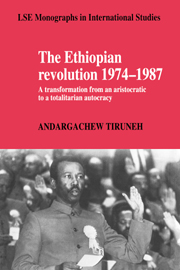 The Ethiopian Revolution 1974–1987
The Ethiopian Revolution 1974–1987 Book contents
- Frontmatter
- Contents
- List of maps and tables
- Acknowledgements
- List of abbreviations
- Map 1 The Horn of Africa
- Map 2 Administrative divisions
- 1 The background to the emergence of the structural crisis
- PART I THE COLLAPSE OF THE OLD-STATE (JANUARY–NOVEMBER 1974)
- PART II THE FORMATIVE YEARS OF THE POST-REVOLUTIONARY ORDER (DECEMBER 1974–FEBRUARY 1977)
- PART III CONSOLIDATION OF POWER (FEBRUARY 1977–SEPTEMBER 1987)
- Postscript
- Appendix: chronology of events
- Notes
- Bibliography
- Index
- LSE MONOGRAPHS IN INTERNATIONAL STUDIES
Postscript
The collapse of Mengistu's regime (1987–1991)
Published online by Cambridge University Press: 18 December 2009
- Frontmatter
- Contents
- List of maps and tables
- Acknowledgements
- List of abbreviations
- Map 1 The Horn of Africa
- Map 2 Administrative divisions
- 1 The background to the emergence of the structural crisis
- PART I THE COLLAPSE OF THE OLD-STATE (JANUARY–NOVEMBER 1974)
- PART II THE FORMATIVE YEARS OF THE POST-REVOLUTIONARY ORDER (DECEMBER 1974–FEBRUARY 1977)
- PART III CONSOLIDATION OF POWER (FEBRUARY 1977–SEPTEMBER 1987)
- Postscript
- Appendix: chronology of events
- Notes
- Bibliography
- Index
- LSE MONOGRAPHS IN INTERNATIONAL STUDIES
Summary
Mengistu's regime, the main focus of this book, collapsed in May 1991. The time of its demise came between the completion of this work in June 1989 and its publication, thus justifying this postscript.
In 1987, Mengistu's regime looked absolutely unassailable. By 1981, he had organized the entire population into numerous kinds of local and national mass organizations. By 1984, he had personally and painstakingly organized the Workers' Party of Ethiopia and subsumed the mass organizations under it. By 1987, he had formalized the structure of the state through a constitution, thus enlarging the state apparatus so much that he was teasingly accused of harbouring secret designs of ruling the entire continent of Africa.
What is more, he had, with the aid and advice of the socialist countries, extended the state's security forces to an unprecedented level in the history of the country. The mass organizations had armed wings within them intended to counter local criminal and counter-insurgency activities. The intelligence department was raised from a section to a ministerial level with branch offices at all the nation's administrative levels and in each of the other government departments. The army, which was well armed by the Soviet Union, was expanded to become the biggest military force in sub-Saharan Africa with almost half a million men under arms. It was with the instrumentality of these forces that Mengistu had managed, by 1978, to liquidate the contending political organizations, contain the regional insurgents, defeat Somali aggression and consolidate his hold on power.
- Type
- Chapter
- Information
- The Ethiopian Revolution 1974–1987A Transformation from an Aristocratic to a Totalitarian Autocracy, pp. 344 - 377Publisher: Cambridge University PressPrint publication year: 1993
